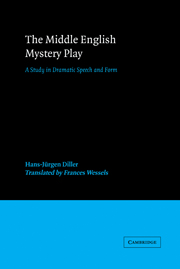Book contents
- Frontmatter
- Contents
- Preface
- Note on texts used
- Abbreviations and special symbols
- Introduction
- Part I The foil: Latin church drama
- 1 Liturgy and drama
- 2 Liturgical point of view surrounding the dramatic core dialogue
- 3 ‘World-containing’ situations
- 4 The dramatization of narrative sources
- Part II The English Creation to Doom cycle
- Notes
- Bibliography
- Indexes
4 - The dramatization of narrative sources
Published online by Cambridge University Press: 04 March 2010
- Frontmatter
- Contents
- Preface
- Note on texts used
- Abbreviations and special symbols
- Introduction
- Part I The foil: Latin church drama
- 1 Liturgy and drama
- 2 Liturgical point of view surrounding the dramatic core dialogue
- 3 ‘World-containing’ situations
- 4 The dramatization of narrative sources
- Part II The English Creation to Doom cycle
- Notes
- Bibliography
- Indexes
Summary
The transposition of mental processes into the dramatic medium
The Easter and Christmas plays, even the Herod plays, grew out of the liturgy, and their language and structure were marked by those origins. The Marian laments were originally lyrical texts and retained their character when they were incorporated into the liturgical plays. As we have seen, they acquired properly dramatic features only in the vernacular. But there is a small group of Latin plays which closely follow their narrative sources in Bible or legend. This group includes above all the miracle plays, but the transformation for the stage can be observed also in plays based on the Old Testament, in the Hortulanus scene which was attached to the Easter Play in the twelfth century, and in the Benediktbeuern plays. Coffman has defined the dramatic technique of the miracle play as ‘the application of the dramatic method to popular, legendary material of the saint's life’. This definition raises the question whether this ‘dramatic method’ cannot be applied to other narrative material as well, and whether there is really ‘the’ one dramatic method which the definition presupposes. The structure of the scenes and plays mentioned above is determined not by the ‘liturgical groundplan’, but by the ‘pragmatic nexus’. The Hortulanus scene above all shows a liveliness of movement and interpersonal relationships that would be unthinkable in the earlier scenes of the Easter ‘play’. Christ and Mary Magdalene do not face each other in the rigid, hieratic confrontation which characterized the meeting between the three Marys and the Angel(s) of the Visitatio.
- Type
- Chapter
- Information
- The Middle English Mystery PlayA Study in Dramatic Speech and Form, pp. 54 - 68Publisher: Cambridge University PressPrint publication year: 1992



